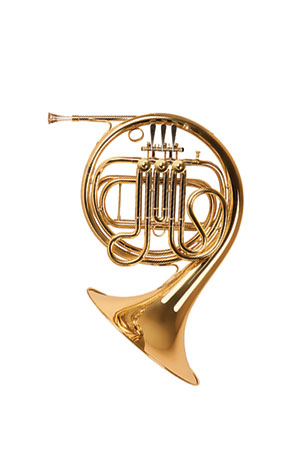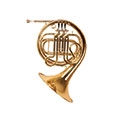 The decline in numbers of young musicians opting to play the horn in band can be countered by returning to the use of single horns for beginning-level students. As advancing students switch to double Bb/F horns, method books and teachers should provide clear instruction on all aspects of how to use the double horn to maximize the benefits of the instrument.
The decline in numbers of young musicians opting to play the horn in band can be countered by returning to the use of single horns for beginning-level students. As advancing students switch to double Bb/F horns, method books and teachers should provide clear instruction on all aspects of how to use the double horn to maximize the benefits of the instrument.
There are likely several contributing factors to the diminished horn population in band programs. Colleagues have speculated that the perceived difficulty of learning the instrument at the beginning stages is a substantial barrier to recruiting and retaining young horn players. Along with the difficulty, colleagues cite their lack of knowledge or comfort with teaching the horn, lack of student familiarity with the horn when choosing a band instrument, and cost to own or rent as a few of numerous reasons why students do not play horn.
Music teachers are using several strategies to increase the numbers and retention of horn players. Many teachers encourage students with natural aural skills, solid academic skills, a good work ethic, and additional music background to try the horn with the belief these students will be more likely to succeed.
During the instrument selection phase teachers take an active approach to promoting the horn: playing musical selections that feature the horn, bringing in older students to demonstrate the instrument, and pointing out the beauty and benefits of the instrument. Teachers might encourage skilled brass players in higher grades to consider switching to the horn and often support continuing horn students by procuring private instruction. Although these strategies are helpful and necessary for recruiting and retaining horn students, it is also worth considering the instrument.
Modern band method books present the double Bb/F horn as the standard instrument for beginners. Interestingly, older band method books do not have fingering charts, pictures of, or instruction on the use of the double horn. These older methods limit their instruction to the single horn. Modern method books have deviated from this pedagogical decision and typically support the double horn. The fingering charts include fingerings for both the Bb and F horn with indications for the use of the thumb key with the Bb fingerings. It is noteworthy that these modern method books provide little, if any, information on when, why, and how to use the Bb side of the double horn.
It is unclear how this change came about, but in any case, the decreasing number of young horn students in band programs correlates with the rise in popularity of the double Bb/F horn as the instrument of choice on which to start beginners. The current trend of giving beginning band students a double horn should be questioned.
When discussing the advantages of the double horn, the most commonly cited answer is that beginning students should become familiar with the fingerings and tuning techniques of the double horn because this will be knowledge they will eventually need if they continue with the instrument. Some suggest that the improved tone quality when the correct side of the double horn is used in high or low register is a good reason to start everyone on the double horn. However, other teachers dispute this reasoning and maintain that the different horns do not affect a beginning student’s tone quality in any register. These advantages seem limited and especially tenuous when compared to the disadvantages of starting students on double horns.
Double horns are heavier than single horns and this could be a negative factor for younger and smaller students, who will tire more quickly and might adopt poor playing posture because of the weight of the instrument. Also, double horns are more complicated. When to use the thumb key, how to tune the instrument and valve slides, and which wrap to use are all questions that can lead to student frustration and discouragement.
The Single Horn
We know that early success on an instrument is one of the best predictors of student retention in the band program. Given the complexities of the double horn, the more approachable single horn, which is less expensive, lighter, and simpler to play, might encourage more students to try the horn, experience more initial success with less frustration, and decide to stick with the horn.
Single horns come in either F or Bb . While a single horn in either pitch would be a better choice for a beginner than a double Bb/F horn, the single Bb has some definite advantages. Of the two singles, the higher-pitched Bb is shorter and lighter than the F horn and therefore more suitable for younger students. However, the most compelling and advantageous reason to start beginning band students on a Bb horn is its inherent pitch stability and the ease of finding the right pitch in typical beginning-band registers.
The Bb horn enables easier and more confident production of pitches because the notes are lower in the overtone series. The intervals between the notes in the lower part of the overtone series are larger than those in the upper part of the series. For a written note C4, a player on an F horn plays the third overtone (not counting the fundamental) of the open harmonic series, while a player on a Bb horn will play the second overtone. For an F horn player, sounding the third overtone is the equivalent of asking beginning trumpet players to play a written C5. If we asked our beginning trumpet players to play in the overtone series where we typically have hornists play, they would be playing between C5 and C6.
An examination of grade 1 band music reveals that the horn part usually falls between written C4 and C5. This is a register where all pitches on a Bb horn are easy to find and play with a good tone. For beginning band students, the Bb single horn is an excellent choice that enables easier and more confident sound production for the range of notes they will perform. As an aside, the stability of pitch and the relative lightness of the Bb horn make it the ideal instrument for those band programs that include a spring marching unit in their programming.
Conclusion
Whether opting to use double horns, single F horns, or single Bb horns with beginners, teachers should ensure that the chosen method book includes a fingering chart for the instrument, and in the case of the double horn, adequate instruction on when and how to use the Bb/F capability. When considering the challenges of the instrument for beginning band students, directors should make thoughtful and informed decisions about how we introduce this instrument to them. Helping students conquer the initial difficulties and complexities of the horn will increase student success and interest and contribute to the resurgence of the horn in school band.






